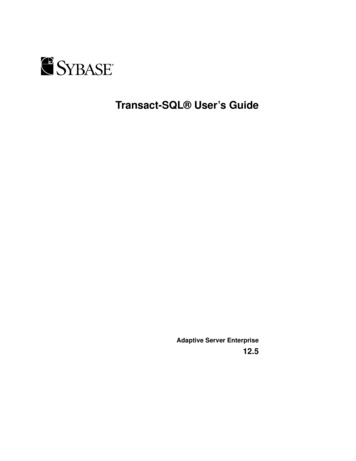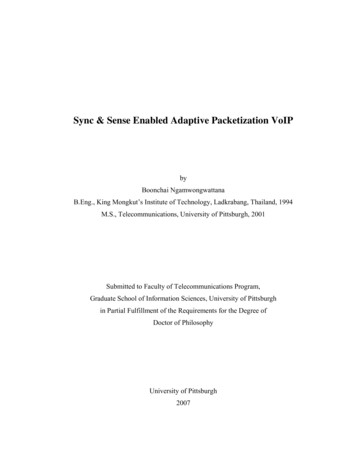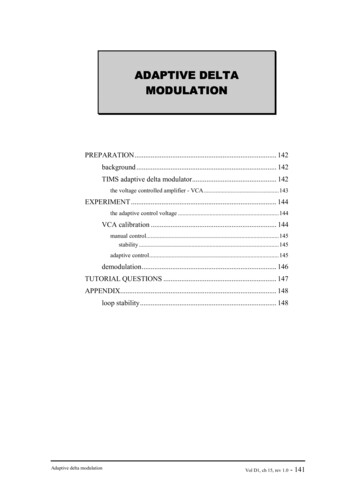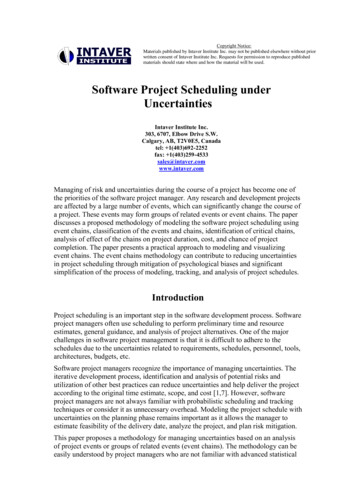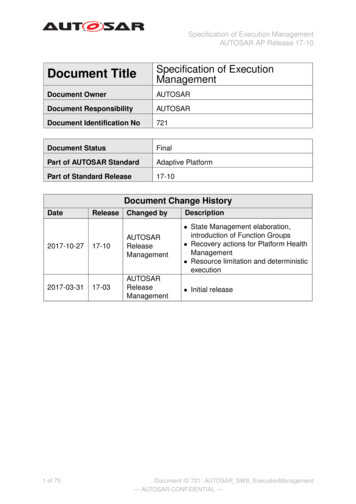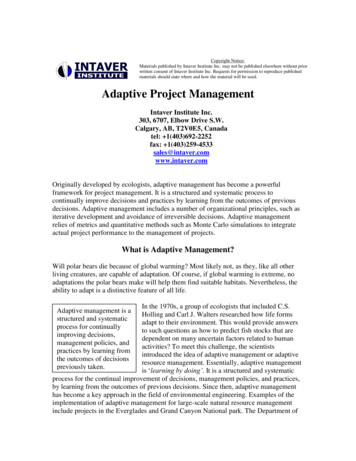
Transcription
Copyright Notice:Materials published by Intaver Institute Inc. may not be published elsewhere without priorwritten consent of Intaver Institute Inc. Requests for permission to reproduce publishedmaterials should state where and how the material will be used.Adaptive Project ManagementIntaver Institute Inc.303, 6707, Elbow Drive S.W.Calgary, AB, T2V0E5, Canadatel: 1(403)692-2252fax: inally developed by ecologists, adaptive management has become a powerfulframework for project management. It is a structured and systematic process tocontinually improve decisions and practices by learning from the outcomes of previousdecisions. Adaptive management includes a number of organizational principles, such asiterative development and avoidance of irreversible decisions. Adaptive managementrelies of metrics and quantitative methods such as Monte Carlo simulations to integrateactual project performance to the management of projects.What is Adaptive Management?Will polar bears die because of global warming? Most likely not, as they, like all otherliving creatures, are capable of adaptation. Of course, if global warming is extreme, noadaptations the polar bears make will help them find suitable habitats. Nevertheless, theability to adapt is a distinctive feature of all life.In the 1970s, a group of ecologists that included C.S.Holling and Carl J. Walters researched how life formsadapt to their environment. This would provide answersto such questions as how to predict fish stocks that aredependent on many uncertain factors related to humanactivities? To meet this challenge, the scientistsintroduced the idea of adaptive management or adaptiveresource management. Essentially, adaptive managementis „learning by doing’. It is a structured and systematicprocess for the continual improvement of decisions, management policies, and practices,by learning from the outcomes of previous decisions. Since then, adaptive managementhas become a key approach in the field of environmental engineering. Examples of theimplementation of adaptive management for large-scale natural resource managementinclude projects in the Everglades and Grand Canyon National park. The Department ofAdaptive management is astructured and systematicprocess for continuallyimproving decisions,management policies, andpractices by learning fromthe outcomes of decisionspreviously taken.
Defense has been exploring adaptive management concepts for environmental cleanup atNavy facilities. The National Oceanic and Atmospheric Administration has utilizedadaptive management for coastal habitat restoration activities.Many engineers from different fields use a number of basic principles of adaptivemanagement without actually understanding the work done by Holling and Walters. In2001, a group of prominent software gurus met in the Snowbird resort in Utah to discusseffective software development processes. During the course of this meeting, they wrotethe “Manifesto for Agile Software Development”. This document offers a number ofbasic principles, which are similar to those of adaptive management: Regular adaptation to changing circumstances, including changing requirements Constant collaboration in project teams and with clients Iterative development processesAt the same time, authors of the Agile Manifest suggested a new idea: effective adaptivemanagement is possible only in creative business environments with self-organizingteams and trusted and motivated individuals.Ideas related to agile project management have spread rapidly beyond softwaredevelopment. Many teams and organizations are applying the agile approach to complexprojects. One of the „relatives‟ of agile project management is flexible productdevelopment. Flexible product development offers the ability to make changes in theproduct, even late in the development cycle.Agile project management and other similar methods focus mostly on the organizationalaspects of adaptation process. Two principles are the most important: Iterative decision-making or making choices based on learning from the outcomesof previous decisions. Strategic flexibility or avoidance of irreversible decisionsAdaptive management processes originally developed by the ecologists were muchbroader. In addition to organizational principles, they include quantitative analysismethods, which will improve decisions by analyzing actual project performance,particularly: Multi-model analysis and hypothesis testing Actual performance measurement Quantitative project cost and schedule risk analysisThe essence of adaptive project management: projects are managed based on learningfrom actual project performance and these learnings are obtained and analyzed usingquantitative methods.Barriers to the Acceptance of Adaptive Management
There is only one living species in the world that often actively resists adaptation –humans. In particular, project managers frequently do not realize that adaptive methodswill most likely bring better project results than traditional project managementprocesses, where the project plan is finalized before initiation.Many organizations embrace adaptive management methods and techniques. Manysoftware development companies and teams actively use some principles of the agileapproach. Nevertheless, traditional project management processes still dominate the fieldof project management.Why are project managers are so reluctant to embrace adaptive management? The answerlies in human psychology. There are a number of psychological biases that preventpeople from accepting adaptive principles.Tendency to Be ConsistentPoliticians often accuse each other of being inconsistent, which in this case is meant to beinterpreted as a character flaw, “Three years ago you supported the war, now you areagainst it. Will you admit to being wrong then, or are you wrong now?” In reality,inconsistency may be not so bad, if it is an acknowledgement of changing circumstancesor new information. For example, if a politician did not initially accept the role ofhumans in global warming, but changed his mind after reading new scientific evidence,most people would agree this decision. The world is always changing, new or additionalinformation is revealed and decision-makers must adapt to the new information. Perhapsthe best politician would be somebody who adapts to changing circumstances rather thansticking to outdated strategies or policiesWhen people are accused of being inconsistent, they tend to become very uncomfortable.Police interrogators or lawyers often use this idea. They try to put people in the positionin which they make inconsistent statements, which makes the subject uncomfortable andprovides a psychological advantage to the interrogators.The tendency to appear consistent is very common in project management. When there isnew information about the project and it is critical that decisions are made quickly to dealthe developing situation, the tendency to consistency is often an obstacle to making thesecrucial decisions. If a device does not work, sometimes it does not make sense to fix it.Building a new device could be a better solution. Project managers have to be willingadmit to errors and adapt to new circumstances.In addition, even if individual project managers are capable of making U-turns, thecorporate culture may not support it. Senior management often frowns upon managerswho stray from project plans.Sunk Cost Effect
In 1996, NASA selected Lockheed Martin to design, build, and fly the X-33 AdvancedTechnology Demonstrator test space vehicle. The X-33 would launch vertically from aspecially designed facility and land on a runway at the end of the mission.In 2001, the X-33 project was cancelled when the project was more than 85 percentcomplete. What happened? The composite liquid hydrogen fuel tank failed during testingin November 1999. In response, Lockheed Martin proposed to complete the developmentof the X-33 by replacing its two composite liquid hydrogen tanks with aluminum tanks.However, NASA concluded the benefits of testing the X-33 in flight did not justify thecost: the X-33 would not be able to reach space with aluminum tanks.NASA‟s investment in the X-33 program totaled 912 million. Despite the hugeexpenditure, NASA cancelled the program. They essentially resisted the sunk cost effect:the tendency to invest more money in a venture in an attempt to recover previous losses.This psychological effect usually prevents project managers from performing adaptiveactions. Instead of stopping work on an ineffective project or course of action, they investmore and more into it with the hope of somehow reviving the project.One well publicized example of the sunk cost effect is the Concord aircraft. The Frenchand British governments continued to fund this aircraft even when it became apparentthat it was no longer economically feasible.Guilt of IndecisivenessOrganizations expect managers to make decisions, even if managers do not have theinformation required to make these decisions. Instead of collecting information andanalyzing data, which may give the appearance of indecisiveness, project managers makeirreversible decisions intuitively, based on their “gut feel.” This style provides theappearance of decisiveness and leadership, regardless of the quality of the decisions.In reality, it is important to analyze when and what additional information is required,how much this additional information will cost, and how waiting for additionalinformation would affect the project‟s bottom line. In other words, it is important to useadaptive management.How does Adaptive Management work?Traditional project management processes include the phases of project planning,execution, monitoring and control and evaluation. If, as a result of an evaluation, is wasfound that something did not go well, this learning may be used in future projects.Adaptive management processes can be active and passive (Figure 1). The main objectiveof passive adaptive management is to incorporate the process of learning into existingmanagement approaches. The learnings obtained from each iteration of the project can beused on the next iterations. In this manner, risk and uncertainties associated with eachiteration can be significantly reduced.
Traditional ApproachReevaluation if Strategy FailedProjectStrategyProjectPlanning andSchedulingProjectExecutionProjectMonitoring andControlProjectEvaluation andReviewPassive Adaptive ManagementAdaptive LearningIterationStrategyIterationPlanning andSchedulingIterationExecutionIterationMonitoring andControlIterationEvaluation andReviewActive Adaptive ManagementAdaptive toring andControlIterationEvaluation andReviewHypothesis testingFigure 1. Traditional project management process versus active and passive adaptivemanagement processes.The goal of active adaptive management is to determine the best managementstrategy through experimentation. The process starts with hypothesis generation, whichinvolves the selection of multiple alternatives for the strategy. The next step is to createmodels for each of the selected alternatives. In practical terms, these models are usuallyproject schedules with a set of risks and uncertainties for the particular iteration. Allalternative models should be evaluated using quantitative analysis such as Monte Carlosimulations. The outcomes of these analyses are duration, cost, chance of meetingdeadlines and other parameters that that may help in the selection of alternatives forexecution.In most cases, only one alternative model will be selected and executed. However, incases with significant risks and uncertainties, it may be more efficient to execute anumber of alternative models at the same time.Here is an example of how active adaptive management can be used:
1. Define a project strategy and high-level project plan. Ensure strategic flexibility:leave room to reverse previous decisions if necessary.2. Divide the project plan into multiple phases or iterations.3. Define a more detailed plan for the next phase or iteration. Do not create detailedplans for future iterations as they may change due to the outcomes of previousiterations. This plan should include a schedule and list of risks (the risk register).You may choose to create multiple alternative project scenarios (project schedulesand risks list) for the same project phase.4. Perform quantitative cost and schedule risk analysis. Different project scenariosmay have a similar cost and duration, but have a different risk profile.Quantitative project risk analysis will help to determine what will happen withproject schedule if certain risks occur. By analyzing this „realistic‟ projectschedule, you can select the optimal scenario to execute in the next iteration.5. Execute one or a couple of project scenarios and continuously measure actualperformance versus original forecasts. Repeat the quantitative risk analysis. If theproject is partially completed, you may have better idea of which risks actuallyoccurred, and which ones did not. In addition, you should be able to calculate thechance that a risk will occur using the performance data. Figure 2 is an exampleof how the results of this analysis may appear.Figure 2. Actual project performance measurement and quantitative risk analysis ofpartially completed projectsCurrently there are a number of advanced project management and risk analysis toolsavailable to perform quantitative analysis. These tools are easy to use knowledge of thecomplex math used to perform the analysis is not required.
Conclusions and RecommendationsAdaptive management is a structured project management framework. It is not aformalized process that must be strictly followed. This framework can be tailored todifferent types of space system design and acquisition projects. Principles of adaptivemanagement are strongly endorsed and actively used in many industries, such asinformation technology and environmental protection.The first rule of adaptive management is simplicity. If adaptive management doesnot bring tangible benefits and causes extra organizational burdens, abandon ineffectiveprocedures as soon as possible.Adaptive management includes the basic principles of agile project management,such as iterative processes and creative business environments. In addition, adaptivemanagement involves the active use of quantitative methods to measure projectperformance and apply learning to improve decisions.Below are the practical recommendations related to implementation of adaptivemanagement for both hardware and software projects:1. Whenever possible, do not define a detailed project plan upfront; instead,use an iterative project management approach.2. Always identify multiple project alternatives or hypotheses; model thesealternatives; and if deemed beneficial, implement a few alternatives at thesame time.3. Use quantitative cost and schedule risk analysis at each phase and iterationof the project.4. Integrate original assumptions and new learning when planning the nextproject iterations.5. Try to minimize the cost of decision reversals; minimize risks by ensuringthat the option to change project direction is always available.6. Ensure that adaptive management is implemented within a creativebusiness environment characterized by a collaborative structure forstakeholder participation and learning.Future ReadingHolling, C. S. (ed.) 1978. Adaptive Environmental Assessment and Management.Chichester: WileyKodukula, P., and Papudesu C., 2006. Project Valuation Using Real Options. APractitioner‟s Guide. Fort Lauderdale, FL: J.Ross PublishingProject Management Institute. 2004. A Guide to the Project Management Body ofKnowledge (PMBOK Guide), 3rd ed. Newtown Square, PA: ProjectManagement Institute.
Virine L., and Trumper, M. 2007 Project Decisions: The Art and Science.Vienna,VA: Management Concepts.Walters, C. 1986. Adaptive Management of Renewable Resources. New York:Macmillan.
Traditional project management processes include the phases of project planning, execution, monitoring and control and evaluation. If, as a result of an evaluation, is was . Planning and Iteration Adaptive Learning Reevaluation if Strategy Failed Scheduling Planning and Project Review Evaluation and Project Control Monitoring and Project .
